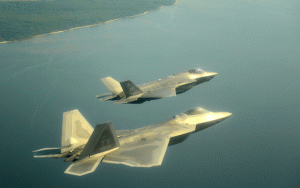2013-09-23 By Ed Timperlake
John Boyd in his lecture (which I sat through twice) had a sine qua non building block for his work: the F-86 versus Mig-15 exchange rate kills by his beloved F-86 in “MIG Ally. ”
The exchange rate was approximately 10 to 1.
Lessons learned at MIG Alley were essential for all of Boyd’s theories.
MIG Alley is a “street” in the Korean skies up to the Yalu River. The “owners” of this “air estate” is South Korea. With such lessons in mind, 15 South Korean Air Chiefs, wrote to South Korean President to not select “Silent Eagle.”
Give the Korean Generals full credit in NOT trying to fight the same type of historically successful MIG Alley fighter sweep engagements. In their letter to the President of South Korea they recognize F-35 technology as moving forward and the “Silent Eagle” vectoring them back to the past.
They know that the F-15 has over a 100+ to 0 kill ratio, yet still make a public request for F-35s.
What makes the fifth gen so formidable is that stealth is a survivability enhancer both offensively and defensively.
The question is simple facing choice between the old and the new:
Is stealth a design factor of adding capability to an existing airframe or multiplying total airframe effectiveness from a new start design?
Airframes have basic design trade off characteristics of range(R), payload (Pl), speed (S) and maneuverability (M).
For example say the characteristics combine to give a US 4th Gen aircraft a relative comparative “score” of a 10 against current competitors and previous aircraft of the last generation.
A US 4th gen legacy aircraft has a hypothetical “10.”
Now along comes the concept of stealth designed into the airframe from the start-so range, payload, maneuverability, and speed in a 5th Gen built from a clean white board design are all enhanced both offensively and defensively by total airframe stealth.
The initial 4th Gen formula would be as follows: R+PL+S+M= a hypothetical 10.
Boeing in their own words with the “Silent Eagle” and “Stealth F/A-18” state they are “adding stealth” to F-15s and F/A-18s but the math is against them.
Their design formula: R+Pl+S+M+Stealth= gets an improved number, say doubling improvements adding Stealth is “+10.” Thus, “+Stealth” creates an airframe performance index that improves from “10” to “20.”
The F-22 and F-35, Russian and PLAAF design teams incorporated “Stealth” from the beginning to enhance the total basic airframe so their 5th Gen formula is (R+Pl+S+M) times “Stealth.”
Doubling improvement in stealth using the same number as mentioned above from initial design is 10 X 10= “100” over legacy additions of “20.”
The “Silent Eagle” and “Stealth F/A-18” are in a design battle they cannot win–and if it were possible to be a fifth Gen fighter by addition, both Lockheed and Boeing would have offered modified F-16 or F-15 or F/A-18 as their prototypes when they competed to build the Joint Strike Fighter.
Also, the F-35 cockpit is a revolutionary exponential cockpit improvement, using Boyd’s OODA loop “Observe, Orient, Decide, Act” formula as the baseline for 21st century operations.
Previously pilots were building “Situational Awareness” (SA) by focusing on Boyd’s “OO” e.g. bubble canopy, improved radars.

Now with F-35 the “SA” is greatly improved to the point that technology enhances the “DA “ part of Boyd’s observation. “Situational decision-making” or SD.
Combine SA with revolutionary SD enhancements, and each F-35 pilot can make immediate actionable “360” “Situational Decisions” in three roles-AA, AG and EW with knowledge of hundreds of miles of air/land and sea battle space.
Individual pilot enhanced information in the cockpit is the building block of a connected and distributed “no platform fights alone” 21st Century Military.
With appropriate integrated tactics-legacy aircraft combat ability can also be greatly enhanced during an air fleet transition.
Also see the following:
https://www.sldinfo.com/wp-content/uploads/2013/01/JFQ-66_85-93_Laird-Timperlake.pdf
https://www.sldinfo.com/reset-rebuild-rethink-us-defense-concepts-of-operations/
https://www.sldinfo.com/the-role-of-the-us-air-force-in-the-future-fight/
https://www.sldinfo.com/shaping-a-new-approach-to-combat-learning-the-role-of-the-f-35/
https://www.sldinfo.com/shaping-the-wolfpack-leveraging-the-5th-generation-revolution/
And on South Korean considerations:
http://www.sldforum.com/2013/05/the-f-35-and-the-pacific-shaping-21st-century-capabilities/
Editor’s Note: Since this piece was first published, the South Korean government has decided to move away from the Silent Eagle.
According to The Wall Street Journal:
Seoul’s Defense Ministry said Boeing’s revamped version of its F-15, the sole contending aircraft to fit under South Korea’s budget cap, fell short of necessary requirements.
Ministry spokesman Kim Min-seok said a majority of the final evaluation committee voted against the F-15 Silent Eagle at a meeting Tuesday.
He cited threats from North Korea and “rapid advances in aviation technology” as reasons for the decision.
And The Korea Times noted:
However, due to the public image of the F-15 SE being developed from a 1970s F-15 platform and having limited stealth functions, the “stealthified” version of the aircraft faced strong opposition.
In response, Boeing stressed that improvements will include its newest radar system.
“We will deliver the APG-82 AESA radar and the Korean Air Force will be the first, other than the U.S. Air Force, to use the system,” said an official.
Despite the improvements, the stealth function seems to have doomed the Silent Eagle, which was to have featured a conformal weapons bay and radar-absorbent material.
To make Boeing’s situation worse, last month, 15 retired Air Force chiefs sent letters to the National Assembly, presidential office and defense ministry recommending the government acquire an “asymmetric air defense capability” to protect against North Korea, which prioritizes stealth jets such as the F-35.
Reportedly, the opposition from the four-star generals “seriously” affected the decision.

